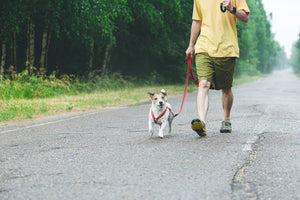Safely Strolling: 7 Essential Tips to Avoid Injury While Walking Your Dog
Oct 09, 2023
Walking your furry friend can be a delightful experience, but it's important to ensure both you and your canine companion stay safe during your outdoor adventures. Follow these seven essential tips to prevent accidents and injuries while walking your dog.
1. Choose the Right Leash (6 ft is Best)
Selecting the appropriate leash is crucial for maintaining control and preventing injury. A standard 6-foot leash provides just enough slack for your dog to explore while allowing you to maintain command. Avoid retractable leashes, as they can lead to entanglement and lack the necessary control, especially in crowded areas.
2. Opt for a Harness Instead of a Collar
Harnesses are a safer alternative to collars, especially for dogs prone to pulling. Unlike collars, harnesses distribute pressure evenly across your dog's body, reducing the risk of neck strain or injury. Choose a well-fitted harness to ensure your dog is comfortable and secure during your walks.
3. Wear the Right Shoes
Investing in a sturdy pair of walking shoes with proper arch support and grip can prevent slips, trips, and falls. Comfortable footwear designed for walking or running will provide the necessary support for your feet, ankles, and knees, reducing the risk of strains and sprains.
4. Stick to a Designated Route
Planning your walking route in advance allows you to avoid potentially hazardous areas. Stick to well-maintained paths and sidewalks, steering clear of uneven terrain, construction sites, or busy intersections. Familiarity with your route helps you anticipate potential obstacles and ensures a safer walking experience for both you and your dog.
5. Stay Off Your Phone
Distracted walking is a leading cause of accidents. Keep your phone in your pocket and stay alert while walking your dog. Being aware of your surroundings allows you to respond quickly to any unexpected situations, such as approaching cyclists, other dogs, or uneven surfaces.
6. Consider the Time of Day
Choose the right time to walk your dog, preferably during daylight hours or well-lit areas in the evening. Visibility plays a significant role in avoiding accidents. If you need to walk during low-light conditions, wear reflective clothing and use a reflective leash or collar for your dog to enhance visibility and reduce the risk of collisions. Additionally, consider walking early in the morning, when others are in bed, or midday, when neighbors are at work.
7. Wear Out Your Dog Beforehand
A tired dog is less likely to engage in overly energetic behavior during walks. Prioritize playtime and exercise at home to help your dog burn off excess energy. Mental stimulation through puzzle toys or training activities can also tire out your dog, making them calmer and more manageable during walks.
Incorporating these tips into your routine ensures that both you and your dog enjoy safe and enjoyable walks together. By being prepared and attentive, you create a positive walking experience that strengthens the bond between you and your canine companion while keeping injuries at bay. Stay safe and happy walking!

